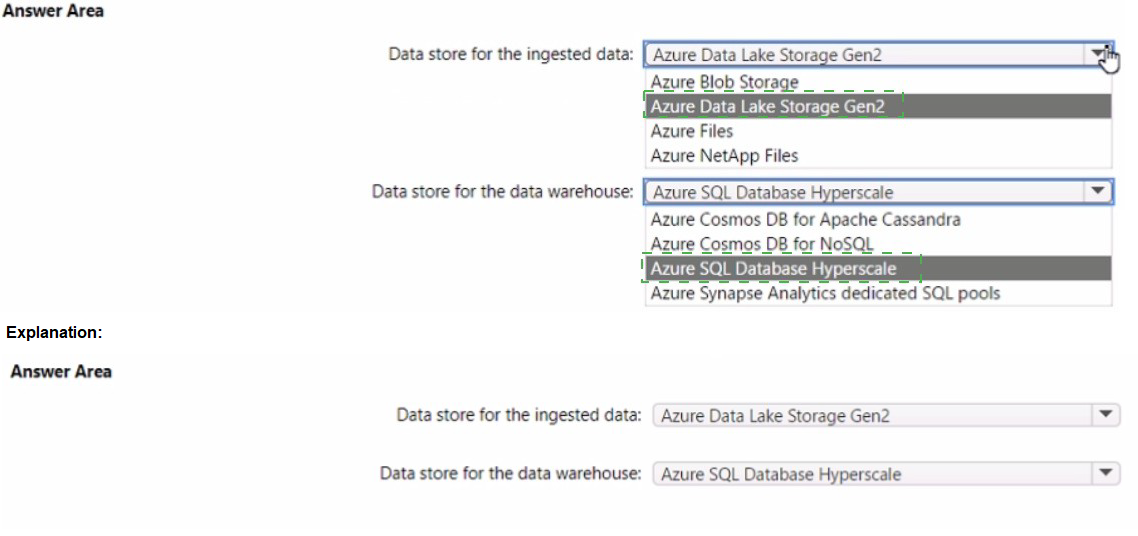
- Email support@dumps4free.com

Topic 5: Misc. Questions
You ate designing an Azure governance solution.
All Azure resources must be easily identifiable based on the following operational information environment, owner, department and cost center. You need 10 ensure that you can use the operational information when you generate reports for the Azure resources.
What should you include in the solution?
A.
Azure Active Directory (Azure AD) administrative units
B.
An Azure data catalog that uses the Azure REST API as a data source
C.
An Azure policy that enforces tagging rules
D.
An Azure management group that uses parent groups to create a hierarchy
An Azure policy that enforces tagging rules
Explanation:
You use Azure Policy to enforce tagging rules and conventions. By creating a policy, you avoid the scenario of resources being deployed to your subscription that don't have the expected tags for your organization. Instead of manually applying tags or searching for resources that aren't compliant, you create a policy that automatically applies the needed tags during deployment.
Note: Organizing cloud-based resources is a crucial task for IT, unless you only have simple deployments. Use naming and tagging standards to organize your resources for these reasons:
Resource management: Your IT teams will need to quickly locate resources associated with specific workloads, environments, ownership groups, or other important information.
Organizing resources is critical to assigning organizational roles and access permissions for resource management.
Reference:
https://docs.microsoft.com/en-us/azure/cloud-adoption-framework/decisionguides/resource-tagging
https://docs.microsoft.com/en-us/azure/azure-resource-manager/management/tag-policies
You are designing a data storage solution to support reporting. The solution will ingest high volumes of data in the JSON format by using Azure Event Hubs. As the data arrives, Event Hubs will write the data to storage. The solution must meet the following requirements:
• Organize data in directories by date and time.
• Allow stored data to be queried directly, transformed into summarized tables, and then stored in a data warehouse.
• Ensure that the data warehouse can store 50 TB of relational data and support between 200 and 300 concurrent read operations.
Which service should you recommend for each type of data store? To answer, select the appropriate options in the answer area.
NOTE: Each correct selection is worth one point.


The application will host video files that range from 50 MB to 12 GB. The application will use certificate-based authentication and will be available to users on the internet.
You need to recommend a storage option for the video files. The solution must provide the fastest read performance and must minimize storage costs.
What should you recommend?
A.
Azure Files
B.
Azure Data Lake Storage Gen2
C.
Azure Blob Storage
D.
Azure SQL Database
Azure Blob Storage
Blob Storage: Stores large amounts of unstructured data, such as text or binary data, that can be accessed from anywhere in the world via HTTP or HTTPS. You can use Blob storage to expose data publicly to the world, or to store application data privately.
Max file in Blob Storage. 4.77 TB.
Reference:
https://docs.microsoft.com/en-us/azure/architecture/solution-ideas/articles/digital-mediavideo
You have an Azure Functions microservice app named Appl that is hosted in the Consumption plan. App1 uses an Azure Queue Storage trigger.
You plan to migrate App1 to an Azure Kubernetes Service (AKS) cluster.
You need to prepare the AKS cluster to support Appl. The solution must meet the following requirements:
• Use the same scaling mechanism as the current deployment.
• Support kubenet and Azure Container Netwoking Interface (CNI) networking.
Which two actions should you perform? Each correct answer presents part of the solution.
NOTE: Each correct answer is worth one point.
A.
Configure the horizontal pod autoscaler.
B.
Install Virtual Kubelet.
C.
Configure the AKS cluster autoscaler.
D.
Configure the virtual node add-on.
E.
Install Kubemetes-based Event Driven Autoscaling (KEDA).
Configure the horizontal pod autoscaler.
Configure the virtual node add-on.
You plan to deploy an Azure App Service web app that will have multiple instances across multiple Azure regions.
You need to recommend a load balancing service for the planned deployment. The solution must meet the following requirements:
Maintain access to the app in the event of a regional outage.
Support Azure Web Application Firewall (WAF).
Support cookie-based affinity.
Support URL routing.
What should you include in the recommendation?
A.
Azure Front Door
B.
Azure Load Balancer
C.
Azure Traffic Manager
D.
Azure Application Gateway
Azure Front Door
Explanation:
Azure Traffic Manager performs the global load balancing of web traffic across Azure regions, which have a regional load balancer based on Azure Application Gateway. This combination gets you the benefits of Traffic Manager many routing rules and Application Gateway’s capabilities such as WAF, TLS termination, path-based routing, cookie-based session affinity among others.
Reference:
https://docs.microsoft.com/en-us/azure/application-gateway/features
| Page 6 out of 56 Pages |
| Previous |